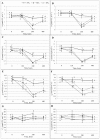Exploration of Chlorophyll a Fluorescence and Plant Gas Exchange Parameters as Indicators of Drought Tolerance in Perennial Ryegrass
- PMID: 31216685
- PMCID: PMC6631610
- DOI: 10.3390/s19122736
Exploration of Chlorophyll a Fluorescence and Plant Gas Exchange Parameters as Indicators of Drought Tolerance in Perennial Ryegrass
Abstract
Perennial ryegrass (Lolium perenne L.) belongs to the common cultivated grass species in Central and Western Europe. Despite being considered to be susceptible to drought, it is frequently used for forming the turf in urban green areas. In such areas, the water deficit in soil is recognized as one of the most important environmental factors, which can limit plant growth. The basic aim of this work was to explore the mechanisms standing behind the changes in the photosynthetic apparatus performance of two perennial ryegrass turf varieties grown under drought stress using comprehensive in vivo chlorophyll fluorescence signal analyses and plant gas exchange measurements. Drought was applied after eight weeks of sowing by controlling the humidity of the roots ground medium at the levels of 30, 50, and 70% of the field water capacity. Measurements were carried out at four times: 0, 120, and 240 h after drought application and after recovery (refilling water to 70%). We found that the difference between the two tested varieties' response resulted from a particular re-reduction of P700+ (reaction certer of PSI) that was caused by slower electron donation from P680. The difference in the rate of electron flow from Photosystem II (PSII) to PSI was also detected. The application of the combined tools (plants' photosynthetic efficiency analysis and plant gas exchange measurements) allowed exploring and explaining the specific variety response to drought stress.
Keywords: MR 820; chlorophyll; delayed fluorescence; gas exchange; plant stress; turf grass varieties.
Conflict of interest statement
The authors declare no conflict of interest.
Figures














References
-
- Radziemska M., Gusiatin Z.M., Bilgin A.A. Potential of using immobilizing agents in aided phytostabilization on simulated contamination of soil with lead. Ecol. Eng. 2017;102:490–500. doi: 10.1016/j.ecoleng.2017.02.028. - DOI
-
- Radziemska M., Bilgin A., Vaverková M.D. Application of mineral–based amendments for enhancing phytostabilization in Lolium perenne L. cultivation. Clean-Soil Air Water. 2018;46 doi: 10.1002/clen.201600679. - DOI
-
- Sung C.Y. Mitigating surface urban heat island by a tree protection policy: A case study of The Woodland, Texas, USA. Urban For. Urban Green. 2013;12:474–480. doi: 10.1016/j.ufug.2013.05.009. - DOI
MeSH terms
Substances
Grants and funding
LinkOut - more resources
Full Text Sources

